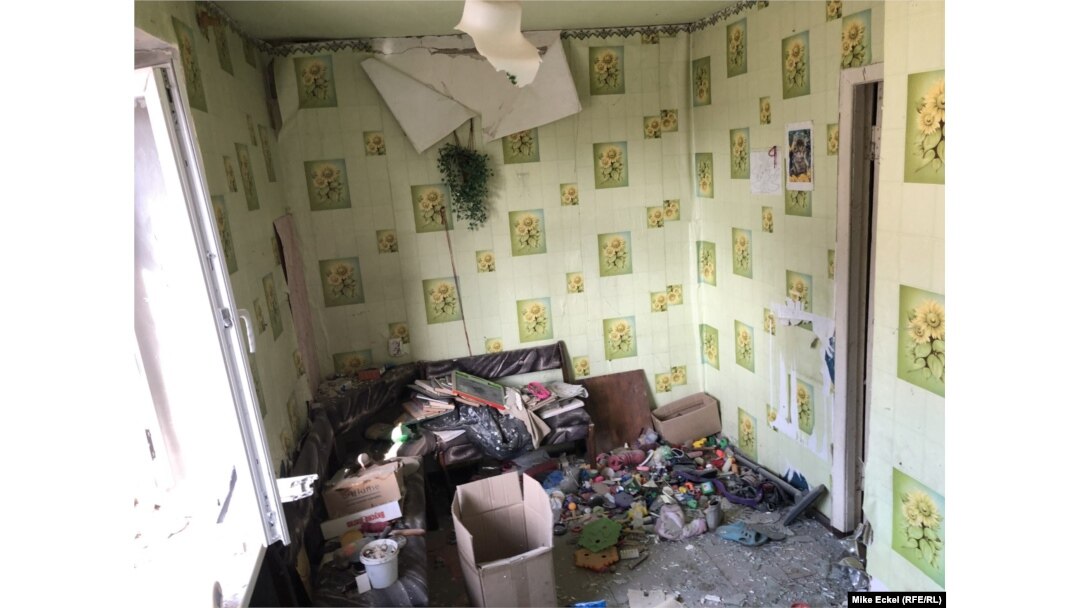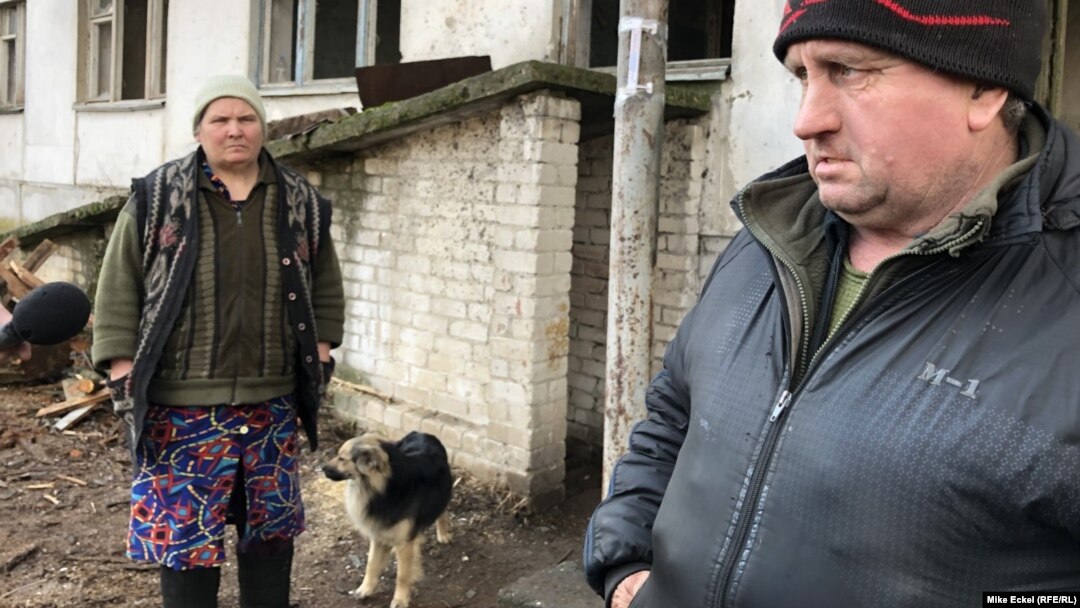TRYOKHIZBENKA, Ukraine – The moment the first rockets exploded, soldiers from a Ukrainian infantry company began yelling, “Grad! Grad!” -- a reference to a terrifying Soviet-designed weapon that can level an entire village in a matter of minutes.
Pale-faced and shaking, Serhiy Averko and his wife, Alla, hobbled as fast as they could down the stairs of an abandoned apartment building, into the mildewy basement, into the pitch-black far corner where a room had been turned into a makeshift shelter and soldiers’ barracks. The sound of the barrage was deafening.
For Ukraine as a country, the prospect of total, massive war with Russia -- which has massed up to 190,000 troops near its borders and on the Crimean Peninsula -- is a terrifying notion. Moscow is poised to send more troops into the eastern Donbas region, where the war between Russia-backed separatists and Kyiv’s forces has killed more than 13,200 people since 2014

A barrage of Grad rockets -- purportedly fired from Russia-backed separatist forces --- hit close to an apartment block in the town of Tryokhizbenka in eastern Ukraine, damaging many people's homes.
For the Averkos, the rocket fire and the panicked rush for shelter were heart-pounding reminders that the existing conflict in the Donbas can be deadly -- and could get worse and wider at any moment.
What made the early years of the war in the Donbas so devastating -- and what could make any potential new major conflict even more so -- is the use of indiscriminate weapons with little or no precision-guided, “smart targeting” capability.
To date, most of the people killed in the conflict have been combatants. The UN human rights agency said that through September 2021, it had recorded 3,095 conflict-related civilian deaths, not including the 298 people killed in the downing of Malaysian Airlines Flight 17 in the war zone in July 2014. The jet was shot down by a Russian-built anti-aircraft missile system that, according to a Dutch-led investigation, was brought to Ukraine by the 53rd Anti-Aircraft Missile Brigade of the Russian Ground Forces and then returned to Russia afterwards.
Your browser doesn’t support HTML5
'It's A Miracle We Survived': Ukrainian Villager Recalls Night Of Shelling
More than 7,000 civilians have been wounded in the nearly eight years of conflict, according to the UN agency. And more than 1.5 million have been displaced, meanwhile, including most of Tryokhizbenka, though locals say most people have moved away not necessarily because of war but because of a lack of jobs or income.
The BM-21 Grad multiple-launch rocket system (MLRS) that purportedly was used on February 22 is Soviet-designed and widely available in arsenals throughout the former Soviet Union. The idea is that the rockets, fired in rapid succession from truck-mounted launchers, while not accurate, can thoroughly level a wide area by striking numerous sections in quick succession, a kind of chessboard effect. Similar but more powerful systems used by the Russian military are known as Uragan or Smerch.
It’s not the first time the Grad -- Russian for “hail” -- has been used in the war in the Donbas, where Russia-backed separatists hold parts of two provinces. In 2015, an MLRS system was used to attack the government-held port city of Mariupol,
killing at least seven people in barrages captured in terrifying dash-cam videos.
Ukrainian forces are also believed to have used indiscriminate rocket fire in the past, including multiple rocket-launch systems.
Tryokhizbenka, about 50 kilometers northwest of the separatist-held provincial capital of Luhansk, and just a few kilometers north of the “line of contact” separating the sides, is mostly deserted. Its two multistory apartment buildings are now empty, and soldiers from a Ukrainian infantry unit are garrisoned in the basements and in forward positions closer to the line of contact. A handful of stand-alone homes -- some decrepit and abandoned, some habitable -- line the road leading to the main central square.
Serhiy Averko stands in the bomb-shelter basement where he and his wife, Alla, huddled with soldiers amid a barrage of Grad rockets.
Serhiy, an unemployed 57-year-old former sawmill worker, said he and Alla have been homeless since September, when an uptick in shelling damaged their home, rendering it uninhabitable.
“It’s just a box now,” Alla said.
They’ve been relying on the goodwill of the infantry unit since then, sleeping in the basement shelter and getting food from the field kitchen that also feeds the soldiers.
“We want to leave. We just have no place to go, no money,” Serhiy said.
Now all but devoid of inhabitants, Tryokhizbenka is near the line of contact separating Ukrainian government-controlled territory from that held by Russia-backed separatists. On February 22, a barrage of Grad rockets hit close to this apartment block, which has an abandoned grocery store in the front.
On February 22, not long after nightfall, a short explosion was followed quickly by another blast, prompting the soldiers in the vicinity to shout and start running into the basement shelters.
Serhiy said he and Alla rushed as quickly as they could, pale-faced and panting, down the makeshift wooden stairs into the dark basement, past a pile of sacks holding cut wood for the barracks’ stove, and pushed into the shelter, then packed with heavily armed soldiers, also breathing fast.
The barrage, which lasted between 15-30 minutes, badly damaged two apartments in a two-story building across the courtyard, strewing shoes, shattered glass, children’s toys, and broken jars of pickled vegetable everywhere. The rockets hit not just Tryokhizbenka but several neighboring villages as well.
A child's stuffed animal can be seen among the debris in an apartment damaged by a barrage of Grad rockets fired at the town of Tryokhizbenka in eastern Ukraine. No one was injured in the attack, which appeared to target a Ukrainian infantry company garrisoned in a nearby building.
“When it began, we ran into the basement. It was horrible, absolutely terrifying. We thought the whole building would come down on us -- five stories on our heads,” Averko said. “I thought, ‘There’s no reason to keep living at this point. This is the end.’”
Two soldiers in the infantry unit, who asked that their names not be published, said the attack was the first in a long time -- possibly ever --in which Grad launchers had been used to target a location were civilians were still living. That claim could not be immediately verified. They blamed the Russia-backed separatists, with one saying, “Why would our own forces be targeting us?”
Rob Lee, a former U.S. Marine Corps officer and war policy researcher at King's College London, said that multiple-launch rocket systems are not accurate, which is dangerous, and that it’s even worse if they use "cluster-type munitions," which spread small bomblets over a wide area.
A Russian BM-21 Grad multiple-launch rocket system (file photo)
"If they haven't used [Grad-type weapons] in a long time, then it probably does represent an escalation," he said of the barrage that hit Tryokhizbenka.
"It’s a miracle we survived,” Serhiy said. “It could've been much worse."
The entire conflict has been traumatizing, Alla said. When they moved to the village, in 2013, the year before the war erupted, they had little in the way of savings, but they had their own house and they could make do with farm animals and a garden, and Serhiy’s small salary.
“Now we have nothing,” she said.
The couple has been sleeping on a single-person bunk in the basement with the soldiers since their home was damaged.
“You know how you watch movies on TV or you see news about wars? And it’s always far away: ‘There’s war in Afghanistan. There’s war in Yugoslavia.’ It’s always so far away, somewhere else,” Alla said.
“But no. Here, war came to us. You understand?” she said. “It came to us, and it’s destroyed everything. There’s nothing.
"And for what?”


